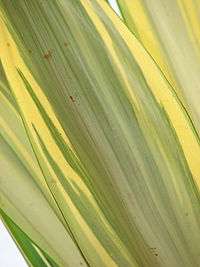Fique
| Fique | |
|---|---|
| Scientific classification | |
| Kingdom: | Plantae |
| Clade: | Angiosperms |
| Clade: | Monocots |
| Order: | Asparagales |
| Family: | Asparagaceae |
| Subfamily: | Agavoideae |
| Genus: | Furcraea |
| Species: | F. andina |
| Binomial name | |
| Furcraea andina | |

Fique is a natural fibre that grows in the leaves of the fique plant, Furcraea andina, a xerophytic monocot native to Andean regions of Colombia, Ecuador, and Peru. From here it was extended to Venezuela and the east coast of Brazil. Common names: Fique, Cabuya, Pita, Penca, Penco, Maguey, Cabui, Chuchao or Coquiza.[1]
The fique plant is often confused with the agave plant. The differences are that the Agave leaves are yellowish and stiff, with a strong spike in the tips, while the Fique plant leaves are droopy and greenish without a spike.
History
The pre-Columbian inhabitants extracted and used the fique fibs for several centuries before the arrival of Spanish conquerors to make garments, ropes, hammocks and many other applications.
In the 17th century, Dutch colonists carried the plant from their Brazilian colonies in Pernambuco to the island of Mauritius. The native inhabitants of the island learned to use the fibre and called it “caraguatá-acú” “croatá-acu” or “gravata”-acú”.
The fibre was also introduced to St. Helena, India, Sri Lanka, Algeria, Madagascar, East Africa, Mexico and Costa Rica.
In the 18th century, in Dagua, Valle del Cauca, Colombia, the priest Feliciano Villalobos started the first rope and wrapping materials manufacturing industry; his products were made of fique. In 1880 the Colombian government reported a yearly production of three million kilograms of fibres, the exportation to Venezuela of two million, the fabrication of five millions pairs of alpargatas and four million metres of rope.
Between 1970 and 1975 the fique industry suffered a crisis brought about by the development of polypropylene, which costs less and is produced much faster.
Today, fique is considered the Colombian national fibre and is used in the fabrication of ethnic products, Colombian handicrafts and recently (since July 2007) has been used for the heath protectors (handmade in Barichara) placed around the Colombian coffee cups sold in the Juan Valdez coffee shops worldwide.[2]
In December 2006 the General Assembly of the United Nations proclaimed 2009 to be the International Year of Natural Fibres, so as to raise the profile of fique and other natural fibres.
Uses
- Packing: The main use of the Colombian cabuya is for the fabrication of sacks and packages for agriculture. According with the number of threads, the products are classified as:
- Ropes: with cabuya one can make very resistant ropes and strings of different calibres, from threads to manilas one inch in diameter. Such ropes are used in the industries of transportation, construction, sailing and many others.
- Arriería accessories: many of the elements used in the pack animals such as enjalmas, cinchas, retrancas, lazos, pretales, tapa de enjalma, and cinchos are handmade with fique.
- Tapestry: the mixed and crude cabuya is used in rugs and tapestry of different size and quality. The fibres can be stained with different organic materials such as avocado seed, achiote and eucalyptus cortex.
- Others: handcrafts, purses, bags, handbags, mattresses, curtains, shoes, umbrellas, baskets and many other products.
Subproducts
- Pulp: Used to produce organic fertilizer and paper
- Leaves juice: Can be used for fabrication of soap, fungicides, alcoholic beverages (homemade tapetusa), organic fuel and animal food.
- Floral stem: The strong floral stem of the fique plant is used in the construction of houses and ladders.
- Bulbs: The pickled terminal bulbs of the plant are edible.
- Medicinal uses: The peasants use the leaves in topic preparations for treatment of boils. The extract of leaves is used against the horse lice.
Cultivation
The fique can be obtained from several species of Furcraea, such as F. macrophylla Baker, cabuya Trel, andina Trel, and castilla. Depending of the process of the fiber and the species used, many varieties of fique fibers can be obtained.[3] Among others:
Main varieties
- Ceniza (ash-colored)
- Espinosa (rough texture)
- Castilla or Golden border
- Sisal
Secondary varieties
- Cabuya verde (green)
- Uña de águila (eagle nail)
- Negra común (black common)
- Chachagueña
- Genoia
- Tunosa común (common spiked)
- Jardineña
- Espadilla
- Rabo de chucha (opossum tail).
Optimal conditions for the growing of the fique plant are:
- Temperature: 19 °C - 23 °C
- Altitude: 1,300 m - 1,900 m
- Annual rainfall: 1,000 mm - 1,600 mm
- Sunlight: 5–6 hours/day
- Soil: dry, rich in silicates.
The fique crops bring nitrogen to the soil, improving its fertility. The plant is very adaptable to different ecological conditions. A fique plant can produce 1 to 6 kg of fibers each year.
Diseases
- Llaga Macana or Rayadilla: a viral disease that attacks all varieties of fique and all the parts of the plant, specially in crops over 1900 m altitude. The disease has no chemical control. It must be managed with preventive measures.
- Pink disease: caused by the fungus Corticium salmonicolor. The disease damages the leaves, disrupting the fibers. Treatment is undertaked with copper-based fungicides. The peasants treat this disease by applying ashes to the base of the leaves.
- Leaf Cochineal (Diaspis bromelia): caused by a parasitic insect.
- Leaf Beetle: a beetle that perforates the base of the leaves.
References
| Wikimedia Commons has media related to Furcraea. |